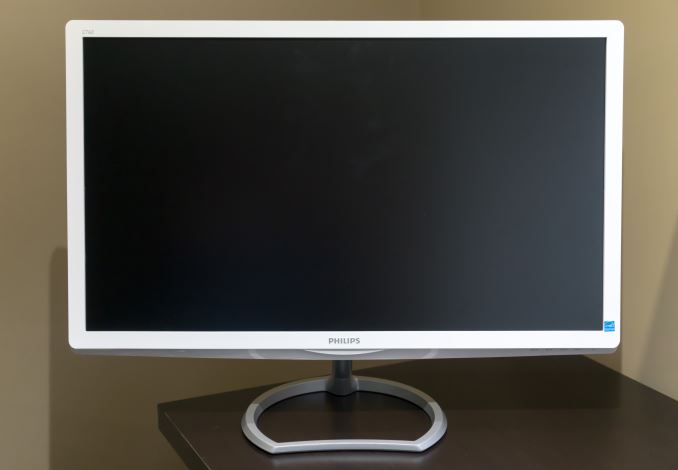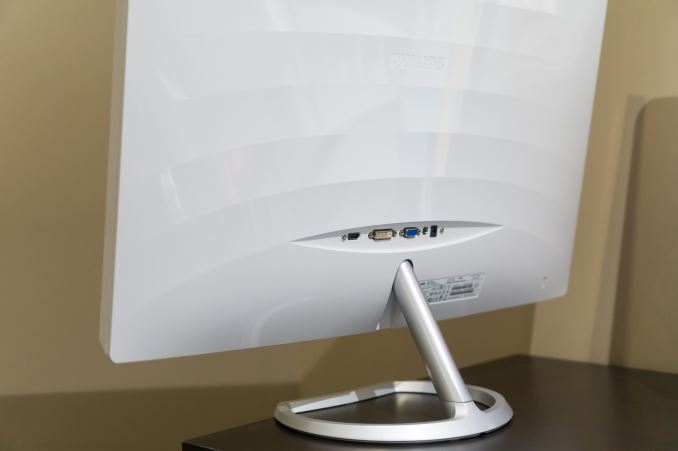A Look At QD Vision's Color IQ And The Philips 276E6 Monitor: Quantum Dots for Wider Color Gamuts
by Brandon Chester on April 28, 2016 8:00 AM EST- Posted in
- Monitors
- Philips
- Quantum Dot
- QD Vision

At this year's CES Josh and I sat down with representatives of QD Vision to discuss their quantum dot display technology, along with where they see the television and monitor market moving in the next few years. QD Vision offers a quantum dot solution for displays, which is branded as Color IQ. The interesting proposition that QD Vision brings to the table with their technology is that it's not just usable in high end displays, but also in less expensive ones where it can be used to bring features that were traditionally limited to high end displays down to a lower price point.
After our meeting with QD Vision, we were informed that Philips would be launching a new line of monitors that use QD Vision's Color IQ technology. Given that these are some of the first computer monitors to come to market with quantum dot technology, I was quite interested in taking a look at it. The monitor in question is the Philips 276E6 monitor, which has a 27" panel and claims to cover 99% of the Adobe RGB color gamut. The full specifications of the Philips 276E6 can be found in the chart below.
| Philips 276E6 | |
| Video Inputs | VGA, DVI-D, HDMI |
| Panel Type | IPS-ADS |
| Pixel Pitch | 0.311 mm |
| Colors | 16.7 million (8-bit) |
| Gamut | 99% Adobe RGB |
| Brightness | 300 cd/m2 |
| Contrast Ratio | 1000:1 |
| Response Time | 5ms GtG |
| Viewable Size | 27-inch |
| Resolution | 1920 x 1080 @ 60Hz |
| Viewing Angle | 178°/178° |
| Backlight | W-LED + QD |
| Screen Treatment | Anti-Glare |
| Tilt | -5° to +20° |
| Dimensions | 640 x 471 x 235 mm |
| Weight | 5.33 kg |
| Accessories | VGA Cable Power adapter |
Before moving forward, there are obviously a few points to address about the Philips 276E6. The first is the resolution and pixel density. At 27", a 1920x1080 resolution is definitely on the lowest end of the spectrum. It's very important to keep in mind that the 276E6 retails for only $300, which really isn't enough to get you a 27" 2560x1440 sRGB monitor unless you can order from Korea and dodge import fees. With that in mind, you're certainly not going to find a 2560x1440 Adobe RGB monitor for $300, and with the purpose of monitors like the 276E6 being to drive down the price of wide gamut displays, this concession makes sense. However, it is true that the pixel density of a 27" 1080p monitor is quite low, and having used a 2560x1440 27" monitor for several years now it did take some adjustment to get used to.
One other point to consider regarding the 276E6 is that, as a wide gamut monitor, it's positioning itself as a product for photographers and other professionals who would like to be able to work in a wider color space. For those applications the relatively low resolution poses less of a problem than applications that involve looking at a great deal of text. The Philips 276E6 is also just the first of many displays that will come to market with this technology, and even for users who are interested in a smaller or higher resolution panel the 276E6 will provide insight into the level of quality that can be expected from this new generation of inexpensive wide gamut displays.
As for the design of the Philips 276E6, I think it's quite unique, but I'm not sure if I'm a huge fan of it. The chassis is definitely on the flimsy side, and the fact that it's made of white glossy plastic doesn't help the visual impression that it's not the sturdiest monitor. The panel has an AG coating, but it's not as heavy as the coatings I've seen on monitors that are really heavily targeted at office use.
The back of the monitor is the same plastic as the front, although the chassis isn't a single component, so there is a gap between the two parts that runs around the edge. The back has a wave-like pattern, which I think looks sort of odd, but it's not really a problem since it's on the back of the monitor where it probably won't ever be seen. All the ports are back-facing rather than down-facing, and they include a port for the power adapter, a VGA port, a DVI-D port, and an HDMI port. There's also a jack for HDMI audio out.
As for the stand, it looks like a fairly study metal stand. However, that's only really true for half of it. The base of the stand is metal, and is removable, but the shaft is made of plastic and is permanently attached to the display. The stand has a degree of tilt, although tilting it too far worries me because the stand can be quite wobbly and I worry that any sudden shift or an impact on the desk may topple it.
One other thing I wanted to comment on is the OSD and the buttons for accessing it. To be quite frank, the buttons are horrible. The response is inconsistent, and you often end up hitting the wrong button by mistake and closing the menu. I wish manufacturers would just use physical buttons, as they're much easier to use and I really doubt that the impact on the bill of materials is significant.
For $300 you're not going to get an aluminum enclosure for your monitor, and in fact you don't really get that even for $1000 unless you buy Apple's Thunderbolt Display. However, I think darker matte plastic would have probably been a better option, and it should have been possible at this price point. Getting a stand with height adjustments and rotation is going to require buying a more expensive monitor, and the tilt range is as much as you'll need for a monitor of this size. Ultimately a monitor is going to be more about function than form, and that's what we'll get to next.











51 Comments
View All Comments
ImSpartacus - Thursday, April 28, 2016 - link
Fascinating read. Intuitively, I didn't anticipate a downside to a wide gamut monitor, so that's interesting to learn about.Though, honestly, as a layman, I have little use for something with that much potential. Cheap Korean panels, hooooooooo!
nathanddrews - Thursday, April 28, 2016 - link
This is only the beginning. With the advent of Rec. 2020 HDR monitors, we are looking at an even more complex calibration system. Even now, HDR televisions effectively have no way to calibrate to a standard. Supposedly Microsoft is working on a W10 update to improve color support for 10-bit and HDR... but without a sincere, ground-up overhaul of color handling, I don't think it will amount to much.Gotta keep the hope, though. I really want to play some HDR games on OLED.
Michael Bay - Thursday, April 28, 2016 - link
I dread the day my insider preview build will mention color profiling. Bugs will be atrocious!crimsonson - Thursday, April 28, 2016 - link
Dolby and SMPTE have offered each a standard for HDR.nathanddrews - Friday, April 29, 2016 - link
Both of which have no good calibration method yet. Ideally, the unit would come pre-calibrated for both dark and bright environments, HDR10 and DV. Of course, if the player and TV could talk to each other to constrain the nit levels to the calibrated display output... I would be in heaven.BrokenCrayons - Thursday, April 28, 2016 - link
Yup, monitors that attempt to display colors accurately or at higher resolutions seem like sort of a pain in the backside to deal with. Certainly, there's good reasons for them, but I'm perfectly happy using bottom-feeder 1366x768 screens for the moment. Higher resolutions aren't important and neither is color accuracy. It's great to see the technology maturing, but you could stick me with a smeary old passive matrix LCD panel from a mid-90s era laptop and it'd be fine.Solandri - Monday, May 2, 2016 - link
As someone old enough to remember the loss of color gamut moving from CRTs to LCDs, I can't wait for sRGB to die so we can move to a more realistic color gamut like Adobe RGB (which is fairly close to the NTSC standard used for CRTs).The color profile problem is only a problem when displaying pictures with a certain color profile on a screen with a different color profile. The problem goes away if everyone uses the same default color profile.
Unfortunately for 20 years now, the default has been the atrocious sRGB. Decades from now, photos and movies shot in this era will be notable for their lack of color saturation, because they were made for the sRGB color space. I quit shooting JPEGs with my DSLR precisely for this reason - my camera's RAW photos cover Adobe RGB space, so by shooting as JPEG I was throwing away a lot of color information.
willis936 - Thursday, April 28, 2016 - link
Excellent write up. Lots of info for getting people up to speed on color management.Michael Bay - Thursday, April 28, 2016 - link
First in was Mami, and now R;N. Animoo certainly conquered AT in these couple of years.Jacerie - Thursday, April 28, 2016 - link
There's a typo in the title. Quantum is spelled with a U not an O.